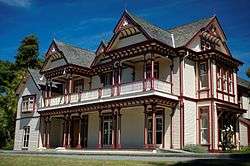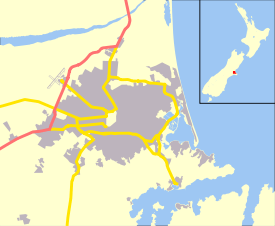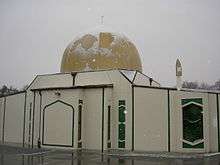Riccarton, New Zealand
| Riccarton | |
|---|---|
| Suburb | |
 Riccarton House (2008) | |
 Riccarton | |
| Coordinates: 43°31′48″S 172°35′51″E / 43.52998°S 172.59744°ECoordinates: 43°31′48″S 172°35′51″E / 43.52998°S 172.59744°E | |
| First European settlers | 1840 |
| Area | |
| • Total | 3.475 km2 (1.342 sq mi) |
| Population (2013)[1] | |
| • Total | 10,563 |
| • Density | 3,000/km2 (7,900/sq mi) |
Riccarton is a suburb of Christchurch. It is due west of the city centre, separated from it by Hagley Park. Upper Riccarton is to the west of Riccarton. Vicki Buck is the Councillor for Riccarton.
History
On 12 April 1840, the ship Sarah and Elizabeth lands Herriot, McGillivray, Ellis, Shaw (and wife) and McKinnon (with his wife and child) who establish a farm at Riccarton. They are the first European settlers on the plains."[2] In January 1841, they abandon their attempt to farm in the area.[3]
Riccarton House was the homestead commissioned by Jane Deans in circa 1855. The Deans brothers, who along with the Gebbies and the Mansons were the second group of Europeans to settle in Christchurch on the same site as the first group in 1843.[4] A replica of their original cob cottage is on the grounds. Riccarton House is now a restaurant and function centre, and conducts regular tours.[5] The Deans brothers, John and William, named the suburb after the parish in Ayrshire, Scotland, in which they were born. They were also responsible for naming the River Avon after the river of the same name in Lanarkshire, Scotland.
Antonio Hall is located on Riccarton Road. A large property with 279 rooms and once described as "one of the finest in Christchurch and vicinity", it has been left to decay despite a Category II listing with Heritage New Zealand.[6][7]
Riccarton Bush
Adjacent to Riccarton House is Riccarton Bush, a prominent feature also known as Deans Bush (Māori: Putaringamotu). The Māori word Pūtaringamotu means either ‘the place of an echo’ or ‘the severed ear’. The latter is a metaphoric expression referring to ‘bush isolated from the rest’. It was one of only two remnants of the original forest that covered the Canterbury plains, escaping the huge fires that swept across the province during the moa hunter period.[8] The other remnant, at Papanui, was cut down in the 1850s. It is dominated by kahikatea trees. A predator-proof perimeter fence has now been erected, with the hope of reintroducing kiwi to the reserve. In 1848, Scots brothers John and William Deans signed an agreement with the New Zealand Company to protect what was originally about 22 hectares of the kahikatea forest at Pūtaringamotu. In 1914, the 6.4 hectares that remained of Deans Bush was formally protected, spearheaded by prominent citizens of Christchurch, including Harry Ell and botanist Dr. Leonard Cockayne.[9]
Riccarton Bush has played an important role in the history of New Zealand entomology, a number of native insects were first collected and named from Riccarton Bush. One of the first collections was of a plume moth Pterophorus monospilalis in 1859 which is now in the Fereday collection held in the Canterbury Museum. Thirty nine families of Lepidoptera are found in New Zealand; 27 of these occur in Riccarton Bush.[10] The moths of Riccarton Bush represent the majority of these families. The bag moth Mallobathra metrosema is only known to occur in Riccarton Bush.[11]
Riccarton Racecourse Hotel
The Riccarton Racecourse Hotel is considered to be one of the most haunted places in New Zealand. It is said that the ghost of former licensee Donald Fraser walks the corridors of the hotel looking for his killer. In 1933, Fraser was murdered in the dead of night in his bedroom, where his wife was sleeping, by two blasts from a double-barrelled shotgun. Despite investigations, nobody was found guilty of the crime.[12]
Governance
Until local government amalgamation in 1989, Riccarton was an independent borough. These days, Riccarton is represented by the Riccarton-Wigram community board.[13]
Economy

Due to its proximity to the University of Canterbury and relatively low rents, Riccarton is home to many Christchurch students. Riccarton Road and Blenheim Road are busy retail zones. Riccarton Road is one of the main motel areas. During 1984-85 the South Island's first mosque, the "Masjid An-Nur" or Mosque of Light, was constructed in Riccarton.[14] It was the world's southern-most mosque until 1999. The suburb is home to many of Christchurch's 2000 Muslim residents.
See also
References
- ↑ The population is the sum of the population in statistical areas of Riccarton, Riccarton West, Riccarton South and Upper Riccarton.
- ↑ "Christchurch: a chronology". Christchurch City Libraries. Retrieved 1 October 2011.
- ↑ "Christchurch: a chronology". Christchurch City Libraries. Retrieved 1 October 2011.
- ↑ "Christchurch: a chronology". Christchurch City Libraries. Retrieved 1 October 2011.
- ↑ "Riccarton House". Riccarton House & Bush. Archived from the original on 5 October 2011. Retrieved 1 October 2011.
- ↑ "Antonio House". Register of Historic Places. Heritage New Zealand. Retrieved 6 February 2017.
- ↑ Matthews, Philip (9 January 2016). "The mystery of Antonio Hall". The Press. p. B1. Retrieved 6 February 2017.
- ↑ "The place of an echo: Pūtaringamotu (Deans Bush)". Envirohistory NZ. Retrieved 26 April 2012.
- ↑ envirohistorynz (21 June 2010). "The place of an echo: Pūtaringamotu (Deans Bush)".
- ↑ Molloy, Brian (1995). Riccarton Bush: Putaringamotu. Christchurch: The Riccarton Bush Trust. p. 263.
- ↑ Monson, Keitha; Emberson, Rowan (2003). Biodiversity of terrestrial invertebrates in Christchurch City: a report for the Christchurch City Council (Report). pp. 37–38. Retrieved 29 April 2016.
- ↑ New Zealand's spookiest stories
- ↑
- ↑ Drury, Abdullah (5 August 2008). "A time for Muslims to examine faith". Nelson Mail. Retrieved 1 October 2011.